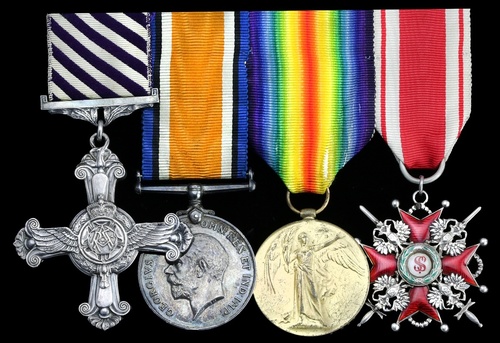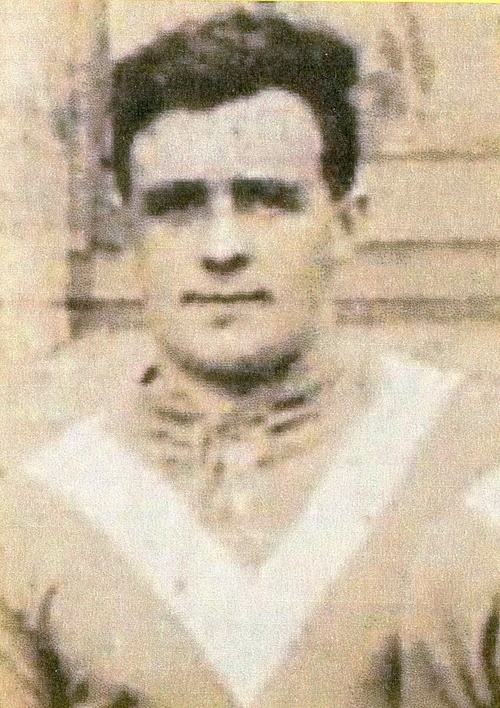Auction: 18001 - Orders, Decorations and Medals
Lot: 17
(x) A rare North Russia operations D.F.C. group of four awarded to 2nd Lieutenant L. Timmins, Royal Air Force, late Royal Naval Air Service, an ex-Sea Scout Airship rating who was taken P.O.W. after being shot down at 300 feet in his D.H. 4 over Zeebrugge in October 1918
Volunteering for further active service in Syren Force on being repatriated, he was decorated for a flurry of daring seaplane missions against the Bolsheviks in the summer of 1919
Distinguished Flying Cross, G.V.R., unnamed as issued; British War and Victory Medals (2 Lieut. L. Timmins, R.A.F.); Russia, Order of St. Stanislaus, breast badge, with swords, 44 x 41mm., silver, silver-gilt and enamel, unmarked, mounted as worn, good very fine or better (4)
D.F.C. London Gazette 22 December 1919:
'In recognition of distinguished services rendered during the War and since the close of hostilities ... Pilot Officer Leonard Timmins (North Russia).'
Leonard Timmins, who was born in Wishaw, Lanarkshire in September 1892, joined the Royal Naval Air Service as an Air Mechanic (Wireless Telegrapher) in April 1915, having already commenced training at the Marconi School. Thereafter, his appointments included services in Sea Scout Airships at Anglesey and as an Observer in D.H. 4s of No. 2 Squadron, R.N.A.S., based near Dunkirk.
In April 1918, No. 2 Squadron became No. 202 Squadron, Royal Air Force, and Timmins, as a recently appointed 2nd Lieutenant, flew numerous sorties from July until 18 October, when, on a dawn reconnaissance to Zeebrugge, his D.H. 4, piloted by Lieutenant Coulthard, was shot down over the mole at 300 feet by machine-gun fire, and crashed into the sea. Reported as missing 'probably drowned', he and his pilot had in fact managed to swim ashore, where they were taken P.O.W.
Repatriated at the War's end, Timmins was embarked for North Russia in July 1919, where he served with distinction in seaplanes of Syren Force, accompanying copied Observer's reports for the period leading up to his return to the U.K. in late September revealing a flurry of operational activity with his pilot, Captain W. H. Park, M.C., D.F.C., including much use of low-level machine-gunning and accurate bombing work.
The following report, written by Timmins after an attack on Bolshevik shipping and piers at Petrozavodsk on 5 August, is indicative of the type of sorties he and his pilot undertook:
'Dropped two large bombs on large pier, both falling in the vicinity of ships lying alongside. Observed nine vessels at large pier, including four paddle steamers, two barges and one very large vessel. Approximately 12 vessels alongside the two smaller piers, four of which steamed out during the bombardment.
A.A. fire from four vessels and pier, and from one gun situated in the town, actual position in trees S.E. of the Cathedral.
In railway station and sidings were approximately 130 trucks and six engines. No signs of aerodrome under construction. Oblique photographs taken of the town and harbour. Fired 300 rounds M.G. on ships and piers ... '
Transferred to the Unemployed List in November 1919, Timmins was awarded the D.F.C. in the following month, together with the 2nd Class Order of St. Stanislaus (Brough's White Russian Awards refers); sold with a comprehensive file of research, with full Syren Force records of operations flown; so, too, of those undertaken in No. 202 Squadron in France and Flanders.
Subject to 5% tax on Hammer Price in addition to 20% VAT on Buyer’s Premium. For more information please view Terms and Conditions for Buyers.
Sold for
£3,600







